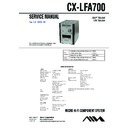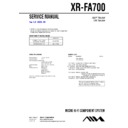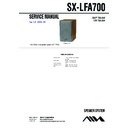Read Sony CX-LFA700 / XR-FA700 Service Manual online
CX-LFA700
AEP Model
UK Model
SERVICE MANUAL
MICRO HI-FI COMPONENT SYSTEM
Sony Corporation
Home Audio Company
Published by Sony Engineering Corporation
9-877-366-01
2003E1678-1
© 2003.05
CX-LFA700 is the Amplifier, CD player, Tape
Deck and Tuner section in XR-FA700.
Deck and Tuner section in XR-FA700.
SPECIFICATIONS
Ver 1.0 2003. 05
Model Name Using Similar Mechanism
NEW
CD
CD Mechanism Type
3ZG-3
Section
Optical Pick-up Name
KSS-213F
TAPE
Model Name Using Similar Mechanism
NEW
Section
Tape Transport Mechanism Type
BZM-1
TUNER
FM tuning range
87.5 MHz to 108 MHz
FM usable sensitivity (IHF)
16.8 dBf
FM antenna terminal
75
Ω (unbalanced)
AM tuning range
531 kHz to 1602 kHz
AM usable sensitivity
350
µV/m
AM antenna
Loop antenna
AMPLIFIER
Power output
Rated: 40 W + 40 W(6
Ω, T.H.D. 1 %,
1 kHz/DIN 45500)
Reference: 50 W + 50 W(6
Reference: 50 W + 50 W(6
Ω, T.H.D.
10 %, 1 kHz/DIN 45324)
MUSIC POWER
100 W + 100 W
MUSIC POWER
100 W + 100 W
Input
AUX IN: 500 mV
Outputs
SPEAKERS: 6
Ω or more
PHONES: 32
Ω or more
CASSETTE DECK
Track format
4 tracks, 2 channels stereo
Frequency response
50 Hz – 10000 Hz
Recording system
AC bias
Heads
Recording/playback
× 1, erase × 1
CD PLAYER
Laser
Semiconductor laser (
λ = 780 nm)
Emission duration: continuous
D/A converter
1 bit dual
Signal-to-noise ratio
80 dB (1 kHz, 0 dB)
Wow and flutter
Unmeasurable
GENERAL
Power requirements
230 V AC, 50/60 Hz
Power consumption
70 W
Power consumption in standby mode
with ECO mode on: 0.25 W
with ECO mode off: 14 W
with ECO mode off: 14 W
Dimensions (w/h/d)
Approx. 155
× 220 × 313.2 mm
Mass
Approx. 5.0 kg
Supplied accessories:
FM antenna (1)
AM antenna (1)
Speaker cords (2)
Remote commander (1)
Batteries (2)
AM antenna (1)
Speaker cords (2)
Remote commander (1)
Batteries (2)
Specifications and external appearance are subject to change
without notice.
without notice.
2
CX-LFA700
1. SERVICING NOTES
······················································· 3
2. GENERAL
·········································································· 5
3. DISASSEMBLY
3-1. Side Panel (R), Side Panel (L) ······································· 7
3-2. Tape Mechanism Deck-1 ··············································· 8
3-3. Tape Mechanism Deck-2 ··············································· 8
3-4. Back Panel, Tuner Unit, D-OUT Board ························ 9
3-5. MAIN Board, AMP Board-1 ········································· 9
3-6. MAIN Board, AMP Board-2 ······································· 10
3-7. Chassis (sub), PT Board ·············································· 10
3-8. Panel (CD) ··································································· 11
3-9. CD Board, CD Mechanism Deck ································ 11
3-10. LED Board, METER Board, HP Board ······················ 12
3-11. FRONT Board ····························································· 12
3-2. Tape Mechanism Deck-1 ··············································· 8
3-3. Tape Mechanism Deck-2 ··············································· 8
3-4. Back Panel, Tuner Unit, D-OUT Board ························ 9
3-5. MAIN Board, AMP Board-1 ········································· 9
3-6. MAIN Board, AMP Board-2 ······································· 10
3-7. Chassis (sub), PT Board ·············································· 10
3-8. Panel (CD) ··································································· 11
3-9. CD Board, CD Mechanism Deck ································ 11
3-10. LED Board, METER Board, HP Board ······················ 12
3-11. FRONT Board ····························································· 12
4. MECHANICAL ADJUSTMENTS
····························· 13
5. ELECTRICAL ADJUSTMENTS
······························· 14
6. DIAGRAMS
······································································ 17
6-1. Block Diagram ······························································ 19
6-2. Printed Wiring Board – CD Section – ························· 20
6-3. Schematic Diagram – CD Section – ···························· 21
6-4. Printed Wiring Boards – AMP Section – ····················· 22
6-5. Schematic Diagram – AMP Section – ························· 23
6-6. Printed Wiring Boards – Front Section – ····················· 24
6-7. Schematic Diagram – Front Section – ························· 25
6-8. Printed Wiring Boards – Main Section – ····················· 26
6-9. Schematic Diagram – Main Section (1/2) – ················· 27
6-10. Schematic Diagram – Main Section (2/2) – ··············· 28
6-11. Printed Wiring Board – HP Section – ························ 29
6-12. Schematic Diagram – HP Section – ··························· 29
6-13. Printed Wiring Board – Meter Section – ···················· 30
6-14. Schematic Diagram – Meter Section – ······················ 31
6-15. Printed Wiring Board – Power Section – ··················· 32
6-16. Schematic Diagram – Power Section – ······················ 33
6-17. IC Pin Function Description ······································· 36
6-2. Printed Wiring Board – CD Section – ························· 20
6-3. Schematic Diagram – CD Section – ···························· 21
6-4. Printed Wiring Boards – AMP Section – ····················· 22
6-5. Schematic Diagram – AMP Section – ························· 23
6-6. Printed Wiring Boards – Front Section – ····················· 24
6-7. Schematic Diagram – Front Section – ························· 25
6-8. Printed Wiring Boards – Main Section – ····················· 26
6-9. Schematic Diagram – Main Section (1/2) – ················· 27
6-10. Schematic Diagram – Main Section (2/2) – ··············· 28
6-11. Printed Wiring Board – HP Section – ························ 29
6-12. Schematic Diagram – HP Section – ··························· 29
6-13. Printed Wiring Board – Meter Section – ···················· 30
6-14. Schematic Diagram – Meter Section – ······················ 31
6-15. Printed Wiring Board – Power Section – ··················· 32
6-16. Schematic Diagram – Power Section – ······················ 33
6-17. IC Pin Function Description ······································· 36
7. EXPLODED VIEWS
7-1. Overall Section ····························································· 40
7-2. CD Mechanism Section ················································ 41
7-3. Front Panel Section ······················································· 42
7-2. CD Mechanism Section ················································ 41
7-3. Front Panel Section ······················································· 42
8. ELECTRICAL PARTS LIST
······································· 43
TABLE OF CONTENTS
3
CX-LFA700
SECTION 1
SERVICING NOTES
SAFETY-RELATED COMPONENT WARNING!!
COMPONENTS IDENTIFIED BY MARK
0
OR DOTTED LINE WITH
MARK
0
ON THE SCHEMATIC DIAGRAMS AND IN THE PARTS
LIST ARE CRITICAL TO SAFE OPERATION. REPLACE THESE
COMPONENTS WITH SONY PARTS WHOSE PART NUMBERS
APPEAR AS SHOWN IN THIS MANUAL OR IN SUPPLEMENTS
PUBLISHED BY SONY.
COMPONENTS WITH SONY PARTS WHOSE PART NUMBERS
APPEAR AS SHOWN IN THIS MANUAL OR IN SUPPLEMENTS
PUBLISHED BY SONY.
CAUTION
Use of controls or adjustments or performance of procedures
other than those specified herein may result in hazardous
radiation exposure.
Use of controls or adjustments or performance of procedures
other than those specified herein may result in hazardous
radiation exposure.
This appliance is classified as a CLASS 1 LASER product.
The CLASS 1 LASER PRODUCT MARKING is located on
the exterior.
The CLASS 1 LASER PRODUCT MARKING is located on
the exterior.
Laser component in this product is capable of emitting radiation
exceeding the limit for Class 1.
exceeding the limit for Class 1.
The laser diode in the optical pick-up block may suffer electrostatic
break-down because of the potential difference generated by the
charged electrostatic load, etc. on clothing and the human body.
During repair, pay attention to electrostatic break-down and also
use the procedure in the printed matter which is included in the
repair parts.
The flexible board is easily damaged and should be handled with
care.
break-down because of the potential difference generated by the
charged electrostatic load, etc. on clothing and the human body.
During repair, pay attention to electrostatic break-down and also
use the procedure in the printed matter which is included in the
repair parts.
The flexible board is easily damaged and should be handled with
care.
NOTES ON LASER DIODE EMISSION CHECK
The laser beam on this model is concentrated so as to be focused on
the disc reflective surface by the objective lens in the optical pick-
up block. Therefore, when checking the laser diode emission,
observe from more than 30 cm away from the objective lens.
the disc reflective surface by the objective lens in the optical pick-
up block. Therefore, when checking the laser diode emission,
observe from more than 30 cm away from the objective lens.
LASER DIODE AND FOCUS SEARCH OPERATION
CHECK
CHECK
Carry out the “S curve check” in “CD section adjustment” and check
that the S curve waveforms is output three times.
that the S curve waveforms is output three times.
NOTES ON HANDLING THE OPTICAL PICK-UP
BLOCK OR BASE UNIT
BLOCK OR BASE UNIT
Notes on chip component replacement
• Never reuse a disconnected chip component.
• Notice that the minus side of a tantalum capacitor may be dam-
• Notice that the minus side of a tantalum capacitor may be dam-
aged by heat.
Flexible Circuit Board Repairing
• Keep the temperature of the soldering iron around 270 ˚C during
repairing.
• Do not touch the soldering iron on the same conductor of the
circuit board (within 3 times).
• Be careful not to apply force on the conductor when soldering or
unsoldering.
4
CX-LFA700
Service Position of the CD Mechanism Deck
Service Position of the Tape Cassette Mechanism Deck
MAIN board
tape cassette mechanism deck (BZM-1)
MAIN board
CD mechanism deck (3ZG-3)




